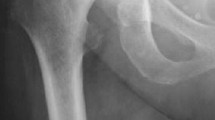Summary
We compared the outcome of cementless hip arthroplasty in patients with chronic rheumatic diseases (cases) and patients with osteoarthritis (controls). Between 1985 and 1993 we implanted 26 cementless hips in 22 patients with Rheumatoid Arthritis, Psoriatic Arthritis or Ankylosing Spondylitis.From a pool of more than 600 patients with Osteoarthritis we chose 40 matched controls (41 hips). Matching variables were year of implantation, age, follow-up‚eight, weight, gender and type of implant. At follow-up (cases: 58 ± 27 months; controls: 56 ± 26 Monate) no signs of loosening or migration of the stem were found, neither in the cases nor in the controls. Loose and/or migrated cups were found in 4 patients with rheumatic diseases (after 44, 65, 65 and 107 months) and in 3 patients with osteoarthritis (after 63, 84 and 100 months). Two cups were revised within 18 months in the control group, in the case group one revision was necessary after 5 years. Loosening and revision rates did not differ significantly (p > 0.20). Clinically, those with Osteoarthritis had a better extension (p < 0.02), were more satisfied with their (artificial) hips (p < 0.05) and did better in some activities of daily living (climbing stairs, dressing, sitting/standing up). Within a mean follow-up of 5 years the results of patients with chronic rheumatic diseases seem to be comparable to those of a matched control-group of patients with Osteoarthritis. Differences between the groups concern areas, in which rheumatic patients are handicapped due to their chronic illness. Nevertheless, we need long-term-results, before we can recommend cementless implants for these patients.
Zusammenfassung
Die zementfreie Implantation von Hüfttotalendoprothesen (Hüft-TEP) bei Patienten mit einer chronisch entzündlichen rheumatischen Erkrankung ist nicht unumstritten, weil ein erhöhtes Lockerungsrisiko durch die Grunderkrankung befürchtet wird. Zwischen 1985 und 1993 wurden bei 22 Patienten mit rheumatoider Arthritis (RA), Psoriasisarthritis oder ankylosierender Spondylitis insgesamt 26 zementfreie Hüftendoprothesen implantiert. Aus einem Pool von über 600 Patienten mit primärer Koxarthrose wurden 40 Patienten mit insgesamt 41 zementfreien Hüftendoprothesen als strukturgleiche Kontrollgruppe (KG) ausgewählt. Beim Follow-up (Rheumatiker: 58 ± 27 Moante; KG: 56 ± 26 Monate) gab es in beiden Gruppen keinerlei Probleme mit den Schäften. Gelockerte und/oder gewanderte Pfannen wurden 4mal (15 %) bei den Rheumatikern (nach 44, 65, 65 und 107 Monaten) und 3mal (7 %) in der KG (nach 63, 84 und 100 Monaten) beobachtet. Pfannenwechsel fanden in der KG 2mal statt, beide innerhalb von 18 Monaten nach Primärimplantation. Bei den Rheumatikern wurde einmal im 5. Jahr nach Primärimplantation die Pfanne gewechselt. Statistisch unterschieden sich die Lockerungsraten nicht (p > 0.20). Innerhalb einer durchschnittlichen Beobachtungsdauer von knapp 5 Jahren scheinen die radiologischen und klinischen Ergebnisse bei Rheumatikern nicht schlechter zu sein als die einer strukturgleichen KG. Es muß aber berücksichtigt werden, daß beim Vergleich kleiner Kollektive evtl. vorhandene Unterschiede eher übersehen werden (hohes β-Fehlerrisiko).
Similar content being viewed by others
Author information
Authors and Affiliations
Rights and permissions
About this article
Cite this article
Lukoschek, M., Simank, HG. & Brocai, D. Outcome of cementless hip arthroplasty in rheumatic diseases. Orthopäde 27, 392–395 (1998). https://doi.org/10.1007/PL00003511
Published:
Issue Date:
DOI: https://doi.org/10.1007/PL00003511




